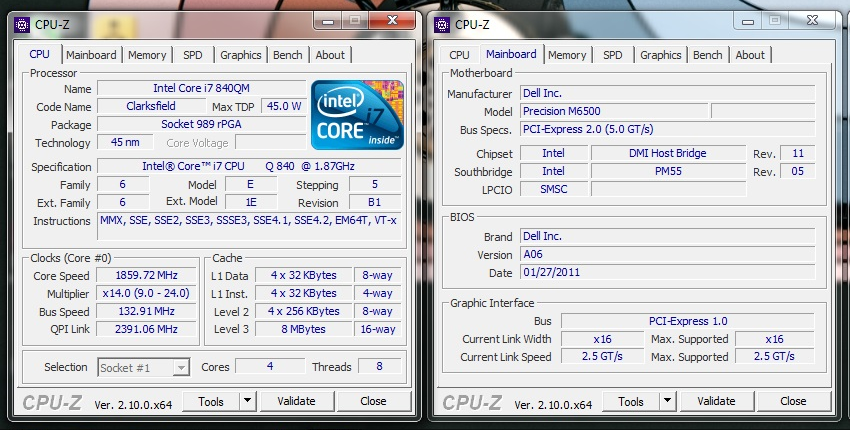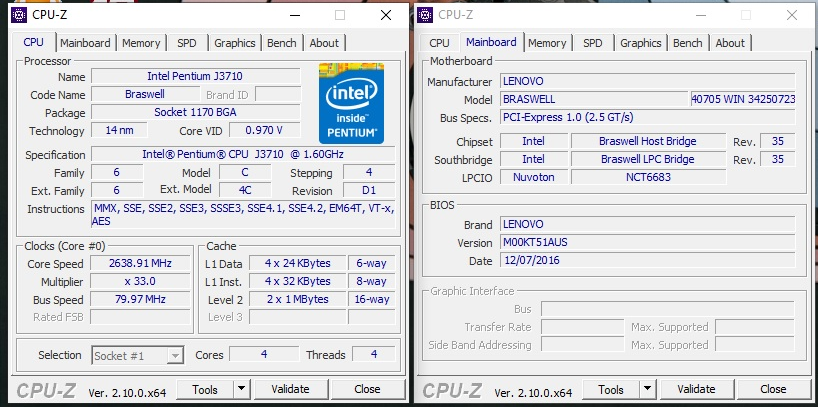
yee245
Members-
Posts
84 -
Joined
-
Last visited
Everything posted by yee245
-
Doesn't that end up making it just kind of a potentially expensive stage of 9900K, 9900KF, 9900KS, and then like 8700K/8086K/9700K/KF? If anything, I'd adjust it to be more like 3 different core counts, no HT allowed (disabling HT allowed). Lumps the 9th gen i7s and i9s into the 8-core score, the 8th gen i7s and the 8th/9th gen i5s into the 6-core score, and then the 3rd score then still is the relatively less common 8350K/9350K/KF as the quad core score, while still leaving it within reach for the smaller teams where you could still use a locked i3 or one of the Pentium/Celerons for that third score. Maybe even specifically allow mobile and Xeons (but not ES) for the stage to increase options for people with hardware meeting the core counts that may not have the normal desktop ones, since you have 2/4/6/8-core in mobile coffee lake (both locked and unlocked) and 4/6/8-core for Xeons. I'm not necessarily advocating for this stage, but that adjustment would allow for a fairly wide range of hardware, where there should be plenty of options for each score, and maybe tries to accommodate smaller teams that might only be able to put 3 scores, rather than needing 4 to have the full team stage. Just my two cents.
-
Please add: Lenovo 2516F9U https://valid.x86.fr/are4bs Thanks.
-
Please add: Dell 0KX350 https://valid.x86.fr/unb9j5 Dell 0DW634 https://valid.x86.fr/drfwru Thanks.
-
Please add: Gigabyte C246M-WU4 https://valid.x86.fr/qq34sy Thanks.
-
Please add: Dell Precision M6500 https://valid.x86.fr/g6hcy5 The validation link doesn't seem to show the mobo model, but attached is what the software shows
-
yee245 - SX58 @ 190MHz - 189.97 MHz Reference Frequency
yee245 replied to radovanslav's topic in Result Discussions
Yeah, I noticed that after saving the score. I don't think I touched any of the voltages in the BIOS, so maybe it's the mobo giving weird readings. -
Please add: Dell 09KPNV https://valid.x86.fr/sbewnk Shuttle SX58 https://valid.x86.fr/blvjdl Dell 0V8WGR https://valid.x86.fr/zc4e20 Thanks.
-
Please add: Lenovo Braswell https://valid.x86.fr/uq15qf Dell 0D9595 https://valid.x86.fr/18s4pv Dell Precision M2400 https://valid.x86.fr/fwmt1k I've attached partial screenshots of the CPU-Z windows in OS for the Braswell and Precision boards for extra info. The Precision board doesn't seem to report anything on the validation link, and I'm not sure what the exact Dell part number is for the board (and eBay seems to show 2 or 3 different part numbers).
-
Please add: Supermicro X7SPA-HF https://valid.x86.fr/tsfupb Dell 0G261D https://valid.x86.fr/zu6zpi (This is a from a Dell Optiplex 960 SFF, which they list on their datasheet as having the Q45 chipset (since CPU-Z shows "Q45/ Q43")) Thanks.
-
Please add Dell 020V4X https://valid.x86.fr/vtgjqw Dell 0651RR https://valid.x86.fr/20snww Dell 0DR9DC https://valid.x86.fr/rwf2b7 Dell 0F284Y https://valid.x86.fr/yg2wi7 Dell 0VXN07 https://valid.x86.fr/3wxcai Thanks.
-
Please add HP 83E9 https://valid.x86.fr/2q1lh7 Acer Ascpire TC-1750 https://valid.x86.fr/3609gx Asrock B550M-C https://valid.x86.fr/py418w Asus M3702WFA https://valid.x86.fr/y5m00p Asus G13CH https://valid.x86.fr/x8idv3 Asus G15DK-C https://valid.x86.fr/uvmr5n MSI MS-AC011 https://valid.x86.fr/hqvxtd Thanks.
-
Please add Asrock B650M-C https://valid.x86.fr/r21p2w MSI MPG Z790 Edge WiFi (MS-7D91) https://valid.x86.fr/z2q2qa (it appears the DDR4 variant is in the database, but not the DDR5 one) Thanks.
-
Please add Dell 0478VN https://valid.x86.fr/r9qw8h The validation link shows "P75/B75" as the chipset, but Dell's datasheet (https://dl.dell.com/manuals/all-products/esuprt_desktop/esuprt_inspiron_desktop/inspiron-660s_reference guide_en-us.pdf) for the Inspiron 660s (which this validation is from) as just being a B75 chipset, in case that affects what chipset it gets put under. Also, not sure if there's an issue adding new mobos to the db since I saw there was mention that cpus couldn't be added at the moment, so probably no rush. Thanks.
-
Could I suggest that there be a limitation on the dogpile stage, assuming it stays this way, that it's by/per socket? That way, it isn't just an exercise in which team can source the most of the 30+ different pga478 socket chipsets, the most of the 60+ different lga775 socket chipsets, the most of the ~17 different lga1155 chipsets, etc. There are still plenty of different sockets to make it a dogpile, but it just makes it so a team just has (or needs) one good z87 score rather than "needing" a h81, b85, q85, h87, q87, z87, h97, and z97 (and also c222, c224 and c226) just for lga1150, for example. So, a team can try to win it on brute forcing different sockets, but not just on the strength of who can find the most of each of the less common chipsets. Also, what would be the ruling on mobile/laptop chipsets? Might be a bunch of work at the end to sort through to make sure there are no laptops with mobile chipsets, but still allowing for if there are obscure-ish desktop boards using mobile chipsets, or something. Allowing them would still at least have some limitations with the per-socket limitation and would require less work and less potential controversy later for what is and isn't allowed with regards to weird/obscure mobos and scores getting pulled at the end, especially if rig pics aren't required (like for the aquamark dogpile last CC). Edit: Also, just adding a submission limit won't fully solve the potential issue of some sockets having a lot of high clocking chipsets, since you still just run into the situation where you have a bunch of high clocking stuff on say 775 or something, even if the other half of them are mediocre. But, a submission limit wouldn't necessarily be a *bad* thing, even if it's just there to prevent filling another 20-30 submissions with random mobile/bga socket stuff. I figure there are probably at least 25 "common" sockets that I think people still bench or at least would have easy enough access to--478, 754, 939, am1, am2, am2+, am3, am3+, am4, am5, fm1, fm2, fm2+, tr4, 1366, 2011, 2011-3, 2066, 1156, 1155, 1150, 1151, 1151v2, 1200, 1700. I also may have missed a couple. Sure, some of them don't clock high and might be outdone by random mobile stuff, but add in a few extra spots for some of the slightly less common stuff that people might still want to pull out, like maybe 370, 423, 462, etc, and even having a limit of 30 or 40 subs per team could still make it competitive and force teams to still actually push the limits, rather than only relying on brute-forcing it with like 50+ scores, as much as I wouldn't mind it having a reason to pull out and bench all my random hardware.
-
interest survey for a xeon / opteron / epyc competition
yee245 replied to skulstation's topic in HWBOT Competitions
I'd just be worried that because there would be competition points "at stake", the competition would just end up being almost entirely pay to win, where you just have the more modern high end expensive stuff winning basically every stage, and not really showcasing some of the older platforms. What about making it like some sort of team competition, but only require 1 sub per stage (so it doesn't exclude people on smaller teams, such that a lone-bencher could still potentially fill out all stages)? Stages could be set up to help force other older platforms, like say, having a stage where it's dual-socket with sub-stages being like DDR1/DDR2/DDR3/DDR4, or something. Or, maybe combine the DDRs, so it might be DDR1+2 for one stage, DDR3 for another, and then DDR4+5 for another, or something. Or, I guess it wouldn't even need to be a team-type comp, but could still just be an individual comp, but having separate stages for the older platforms gives someone who has one or two of those a chance against someone that might just have some dual Epyc system, since they can just sub in an equal amount of stages. Or, make it kind of like the push the hardware style comp, where the various rounds are picking different "generations" of server/workstation hardware--perhaps separated by DDR version. That way, it's at least closer competition between people running say DDR2 platforms against other DDR2 platforms or DDR3 against DDR3 on more period-relevant benches (like older cinebenches or something for the older stuff, but cinebench2024 or ycruncher 10b/25b for newer stuff), since they're not going to have to compete with something 10-15 years newer. Not sure exactly how to make it "fair", but just throwing out an idea to at least incentivize subbing older stuff, or at least have a chance of showing off some of the older stuff, rather than just all the top scores all being recent hardware. -
Please add 0X30MX https://valid.x86.fr/afxgq1 0KYWH7 https://valid.x86.fr/8n2s6h Aspire TC-1770 https://valid.x86.fr/34730s 00JG8P https://valid.x86.fr/qqtpn4 05KMX5 https://valid.x86.fr/f9bw5r Thanks.
-
Please add Asus B85M-G R2.0 https://valid.x86.fr/l66q7s
-
An alternate/second version the Xeon E3-1225 v3 should be added to the database as something like "Xeon E3 1225 v3 (HT)". There is an early version of this processor that shipped with hyperthreading enabled, and Intel disabled it on later chips. https://valid.x86.fr/8me9kh Additional details seem to be available on the LTT forums, including Intel's Product Change Notification: https://linustechtips.com/topic/47244-4-threads-or-8-threads-8-threads-version-of-xeon-e3-1225-v3-is-available-in-japan/
-
You can look at the OC Esports page. The bottom "half" of the page is all the submissions in the order they were subbed: https://esports.hwbot.org/#!/round/country cup 2023misc/5759/aquamark_dogpile_-_max_60_subs
-
Please add Dell 0TP412. Thanks. https://valid.x86.fr/gle8g4
-
For that Night Raid iGPU stage (https://hwbot.org/competition/country cup 2023GPU/stage/5732_3dmark_-_night_raid_-_igpu_amd), are laptop chips intended to be allowed to be allowed (e.g. the FP5, FP6, FT6, FP7, etc socket chips)?
-
Please add the Ryzen 5 5600X3D. https://valid.x86.fr/kdc3vq https://www.amd.com/en/products/cpu/amd-ryzen-5-5600x3d Thanks.
-
Please add Asus PN63-S1. Thanks. https://valid.x86.fr/y0iuwv
-
yee245 - Athlon II X3 455 @ 151.2MHz - 1 cb Cinebench - R15
yee245 replied to yee245's topic in Result Discussions
I think it was about 13.5 hours.




